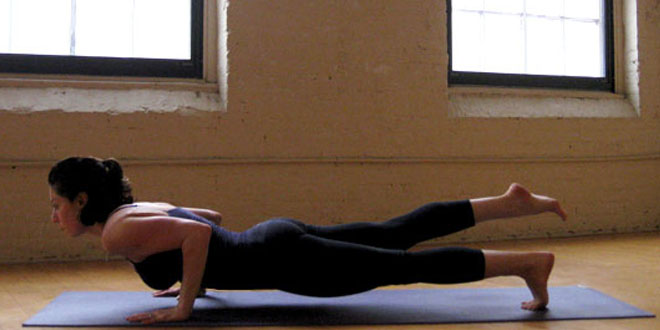
Blissful relief with the four-limbed staff pose
Four-limbed staff pose, also known as Chaturanga Dhandasana (chaht-tour-ANG-ah don- DAHS-anna), is a type of yoga that focuses on arms, chest and the abdomen.
Following are the steps involved in this posture:
STEP ONE
First, you need to perform a downward-facing dog pose, followed by the Plank Pose. Care must be taken to make sure that your shoulders are pressed strongly against your back and after that push your tailbone towards the pubis.
STEP TWO
Now breathe out and slowly lower your trunk and limbs towards the floor until only a few inches remain. Ensure that your body is parallel to the ground and your legs are straight. In this posture your lower limbs should be turned inward and your tailbone towards the navel to keep your legs straight.
STEP THREE
Don’t let your elbows splay out to the sides but hold them to the side of the trunk and push them backwards towards the heels. Press the bases of fingers strongly to the floor and keep your shoulder blades wide apart.
STEP FOUR
Your neck should be aligned straight with the back torso and then gaze forward. Remain in this posture for 15 to 30 seconds. Then, with an exhalation, lie down slowly on the ground or go to Plank posture.
Chaturanga Dhandasana is part of the Sun Salutation sequence and it can also be practiced independently anywhere.
BENEFITS
1) Strengthens arms and wrists.
2) Tones abdominal region.
3) Corrects overall posture.
4) Improves equilibrium and balance.
5) Relieves anxiety and depression and calms down.
FOR BEGINNERS
This pose is useful in such a way that it prepares yogis for equilibrium required for more complex postures. If you are new to yoga, it might be difficult for you to perform this posture, as it requires great strength of arms, legs and back. Feel the power gathering at your wrists as you master this posture.
PRECAUTIONS
1) Do not practice it if you are pregnant.
2) Avoid if you have carpel tunnel syndrome.
3) It should be trained under supervision of yoga instructor.
4) Take doctor’s consent to do so.
MODIFICATIONS
1) Practice it against a wall in a standing upright posture.
2) To add to the challenge of this posture, shift the trunk a little forward and roll over your feet balls onto the tops of your feet. This brings your waist beside your hands.

